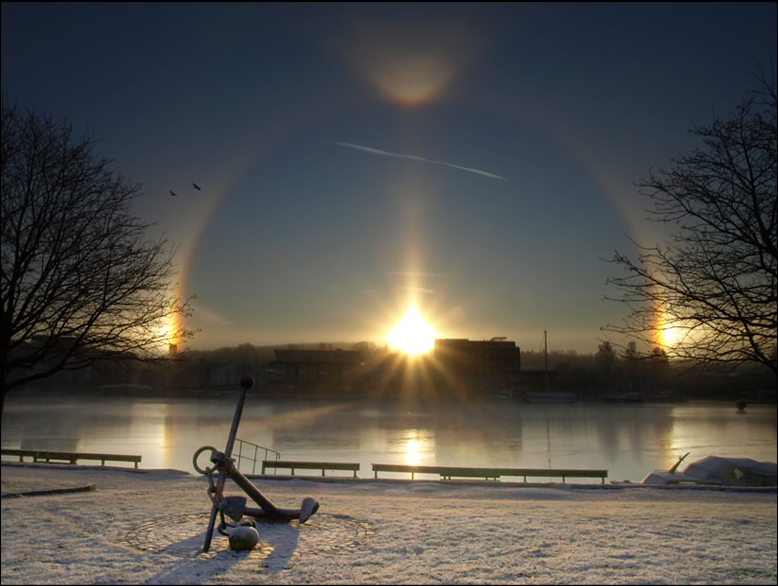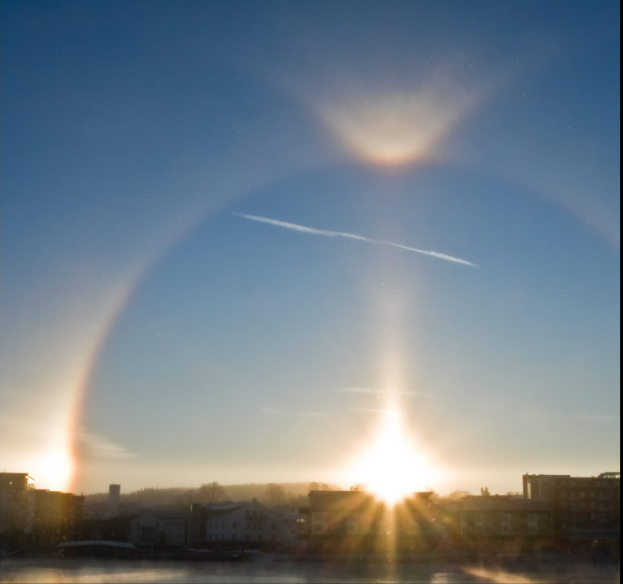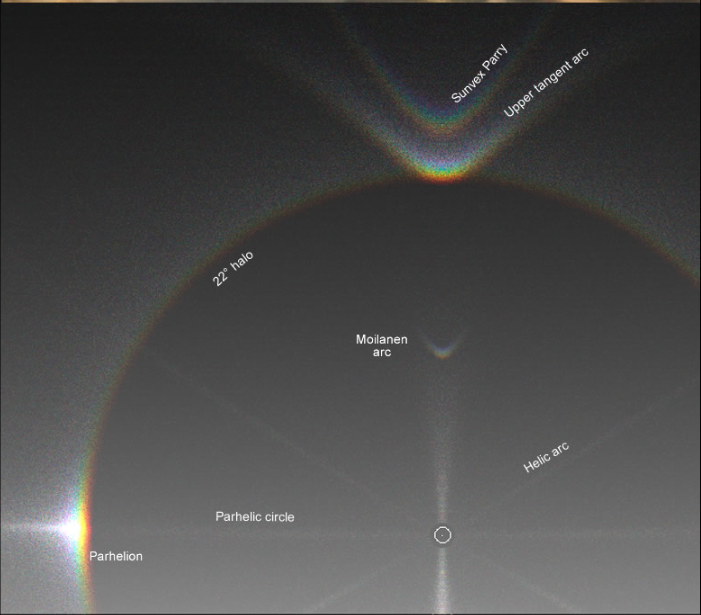Norwegian rare arcs
Norwegian Rare Arcs: A Spectacular Display of Atmospheric Optics
Norway, known for its stunning natural landscapes, occasionally treats its residents and visitors to a breathtaking display of atmospheric optics. These rare atmospheric phenomena, known as Norwegian rare arcs, are a sight to behold. In this article, we will delve into the mesmerizing details of these rare arcs and explore the various optical features they encompass.
The Enchanting Components of Norwegian Rare Arcs
Norwegian rare arcs consist of several distinct optical features that combine to create a visually stunning spectacle. Let's take a closer look at each of these components:
-
Sundogs: These bright spots on either side of the sun are generated by diamond dust plate crystals. They add a touch of radiance to the overall display.
-
Sun Pillar: A vertical shaft of light extending above or below the sun, created by the reflection of sunlight from ice crystals in the atmosphere.
-
22-Degree Halo: An almost semi-circular arch surrounding the sun, formed by the refraction and reflection of sunlight by hexagonal ice crystals. It is a common optical phenomenon, but an integral part of Norwegian rare arcs.
-
Upper Tangent Arc (UTA): This arc touches the top of the 22-degree halo and curves sharply upwards as the sun climbs. It is formed by column crystals and exhibits a gull wing shape.
Discovering the Hidden Gems within Norwegian Rare Arcs
Norwegian rare arcs often reveal hidden gems that require a discerning eye to spot. Let's explore some of these rare optical phenomena:
-
Sunvex Parry Arc: Within the UTA, a rare halo known as the sunvex Parry arc can sometimes be observed. It adds an extra layer of intrigue to the already captivating display.
-
Moilanen Arc: Positioned between the UTA and the sun, the faint V shape of a Moilanen arc can sometimes be glimpsed. This elusive halo adds an element of rarity to the overall spectacle.
-
Helic Arc: In certain instances, a helic arc, produced by external reflection from the side faces of Parry-oriented crystals, can be observed. This arc is particularly challenging to spot but adds another layer of complexity to the display.
-
Middle Lowitz Arc: With keen observation and strong image enhancement, traces of a middle Lowitz arc curving upwards outside the 22-degree halo may be discerned. This arc then becomes tangent with the base of the Parry arc, creating a captivating visual effect.
Unveiling the Mechanics Behind Norwegian Rare Arcs
The intricate formation of Norwegian rare arcs can be attributed to the specific characteristics of ice crystals in the atmosphere. The HaloSim ray tracing technique provides valuable insights into the composition and arrangement of these crystals:
- A mix of 55% random oriented crystals, 16% plates, 25% singly oriented columns, and 4% Parry columns were used in the simulations.
- The high efficiency of Parry arc generation is highlighted by its comparable brightness to the UTA. This efficiency is crucial in enabling us to witness the arcs discovered by William Edward Parry.
While the exact formation mechanisms of the Moilanen arc remain uncertain, simulations indicate that ice wedges with a 34° angle are involved. The rays of this arc somehow pass between facets inclined at this specific angle, adding to its mysterious allure.
Captivating Images of Norwegian Rare Arcs
The accompanying images provide a glimpse into the enchanting world of Norwegian rare arcs. Photographed in Porsgrunn, Southern Norway, on December 31, 2008, by Morten Kleiva, these images capture the sheer beauty and intricacy of these atmospheric optical phenomena. They serve as a testament to the remarkable displays that nature occasionally bestows upon us.
In conclusion, Norwegian rare arcs offer a truly captivating experience for those fortunate enough to witness them. From sundogs and sun pillars to the 22-degree halo and its accompanying components, these optical phenomena paint the sky with an otherworldly charm. Delving deeper, we uncover the hidden treasures of the sunvex Parry arc, Moilanen arc, helic arc, and middle Lowitz arc, each adding their own mystique to the spectacle. As we continue to study and simulate these rare arcs, we gain a better understanding of the intricate mechanisms at play. So, keep your eyes to the sky and embrace the wonder of Norwegian rare arcs whenever they grace us with their presence.

Rare Ice Halos at Porsgrunn, Southern Norway imaged by Morten Kleiva on the morning of 31 December '08 with the temperature at minus 12C. ©Morten Kleiva, shown with permission.
A beautiful photograph of a beautiful and rare display.
The obvious features are the bright sundogs generated by diamond dust plate crystals, a sun pillar and the almost semi-circular arch of a 22-degree halo. Touching its top is an upper tangent arc from column crystals. At this low sun the UTA curves sharply upwards. It opens up into a gull wing shape as the sun climbs.
Within the UTA and better seen in the second photo is a rare halo, a sunvex Parry arc.
Between the UTA and the sun is a rarer halo still. The faint V shape of a Moilanen arc is faintly visible. Check the labeled simulation below for its location.
There is a hint in the second image of another rare halo - a helic (old name heliac) arc produced by external reflection from the side faces of Parry oriented crystals.
Primed by foreknowledge and averted imagination you might also discern traces in the second image of a middle Lowitz arc curving upwards outside the 22 degree halo to become tangent with the base of the Parry arc. No claims are made for this but strong image enhancement gives indications of it plus an upper Lowitz arc. See this image for the appearance of an a middle Lowitz at a similar solar elevation.
The HaloSim ray tracing used a mix of 55% random oriented crystals, 16% plates, 25% singly oriented columns and 4% Parry columns.
That the Parry arc is roughly as bright as the UTA highlights the very high efficiency of Parry arc generation. Without that efficiency we would almost never see the arcs of William Edward Parry.
The Moilanen arc was separately simulated with ice wedges of 34° angle. We do not know what crystals actually form it in nature except that its rays somehow pass between facets inclined 34 degrees to each other.


Note: this article has been automatically converted from the old site and may not appear as intended. You can find the original article here.
Reference Atmospheric Optics
If you use any of the definitions, information, or data presented on Atmospheric Optics, please copy the link or reference below to properly credit us as the reference source. Thank you!
-
<a href="https://atoptics.co.uk/blog/norwegian-rare-arcs/">Norwegian rare arcs</a>
-
"Norwegian rare arcs". Atmospheric Optics. Accessed on November 26, 2024. https://atoptics.co.uk/blog/norwegian-rare-arcs/.
-
"Norwegian rare arcs". Atmospheric Optics, https://atoptics.co.uk/blog/norwegian-rare-arcs/. Accessed 26 November, 2024
-
Norwegian rare arcs. Atmospheric Optics. Retrieved from https://atoptics.co.uk/blog/norwegian-rare-arcs/.